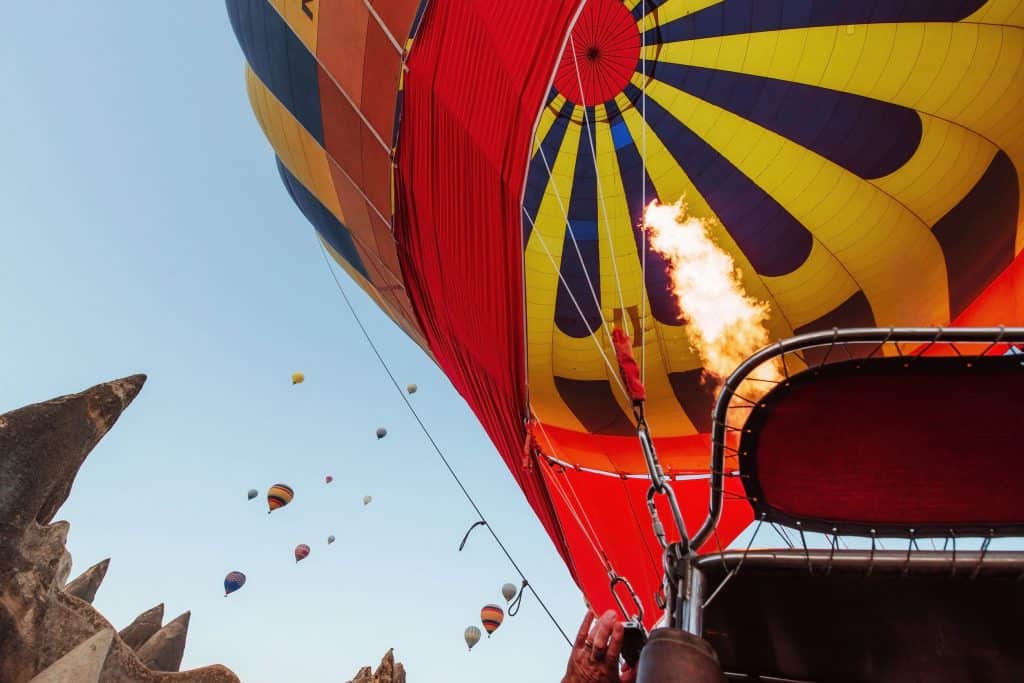
Using the right fuel in a hot air balloon is literally the difference between flying and being stuck on the ground. If you’re wondering what fuel to use in your next hot air balloon adventure, then this is the article for you!
Hot air balloons all use liquid propane to fuel their flight. This is the same kind of liquid propane that is sold at Walmart or any other average convenience stores. The propane is stored in stainless steel, titanium, or aluminum fuel tanks that can hold 10-30lbs of propane.
Using the liquid propane correctly is what really matters, of course. Even using the right fuel won’t help if you don’t know how to use it!
Why Propane?
To answer this question, you first need to understand what makes hot air balloons fly. Hot air balloons, like their name implies, fly because of hot air. When the envelope (or what a layman might call the balloon) fills with air that is hotter than the air outside the envelope, it starts to rise.
This leads us to the need for propane. There needs to be a safe and efficient way to make the air in the envelope warmer than the air outside of it. The answer is propane!
While there are other ways to achieve flight in a balloon, part of being a hot air balloon means you use hot air to fly. Balloons that don’t use propane to heat the air inside the envelope are actually called gas balloons.
Liquid propane stored in stainless steel, titanium, or aluminum tanks gets easily turned into a gas by a simple burner. An average tank of propane used on a hot air balloon weighs anywhere from 10-30lbs. which makes it ideal for flight due to its low weight.
Propane provides the necessary criteria for creating a safe and efficient way to heat the inside of the envelope. As compared to other gases, especially methane, propane is also easier to store and transport. This is largely because it achieves a liquid state at lower temperatures.
Where to Get the Best Liquid Propane for Hot Air Balloons
You could easily settle for common liquid propane found at your local convenience store. However, this would not give you the best results possible. There are several things you should know before purchasing propane.
The first thing you should know is that getting the right container for your propane is almost as important as getting good propane. If you already own a hot air balloon, you should check the exact dimensions of your basket to make sure a certain tank would fit. If you don’t own a hot air balloon yet, consider purchasing the tanks that come recommended with your basket.
The second thing to know is that better propane means farther flight distances. The average balloon burns about 15lbs. of propane an hour. Finding propane that is prepared specifically for hot air balloons may greatly decrease the amount of propane you use per hour, and thus greatly increase the amount of time you can spend in the air.
The third, and perhaps most important thing to know, is that there are as many good options as there are bad options. I won’t make any brand endorsements here because the best way to the right propane is simply by following the above tips.
With these tips in mind, you can’t possibly go wrong with your next propane purchase!
Knowing How Much Propane to Prepare
There’s a lot of preparation that goes into flying a hot air balloon. One of the most important questions to ask is how much propane you should bring on your next trip.
If you’re just a crew member on a hot air balloon, this is a question for the pilot to answer. If you’re panicking right now because you ARE the pilot, don’t worry! We can answer this question together.
The first thing you need to do in answering this question is asking how long you want to fly for. Because you can’t do too much in the way of directing your path as you fly, it’s not important to ask how far you want to fly. That part will be left up to Mother Nature.
After you’ve decided how long you want to be in the air, review how long a tank of propane can last with your balloon AND the cargo it carries. The heavier the basket, the more strain that’s put on your propane reserve. Seeing as how this will vary from flight to flight and balloon to balloon, you’ll probably need a calculator to answer this question.
Next, make sure you overestimate. If you normally use a 30lb. tank for a flight, anticipate using 40lbs. Always bring extra!
Because landing uses almost no propane, running out of propane isn’t normally dangerous. That having been said, it certainly does kill the fun. Being prepared with the right amount of propane ensures a good time for all involved!
Attaching and Using a Propane Tank

Each propane tank will attach to a hot air balloon tank differently. This has more to do with the balloon than the tank. Review pre-existing containment apparatus’ on your balloon before making any decisions on how to use and store your propane tank.
Many hot air balloons will have one burner frame that is located over top the basket. There will then be one, or several, spots in the basket to hold extra propane tanks. Locate the tube that attaches the burner frame and the propane tanks. Then simply screw the tube from the burner frame onto a propane tank.
In terms of using the propane tank, all you have to do is turn the tank valve to the desired intensity. Once the burner is activated, turning the valve on the propane tank controls the height and strength of the flame.
The pilot should always start by turning the valve on the propane tank roughly half the way on. This will give you an idea of how much propane is released by each twist of the valve.
Over time, it will become second nature to you to know how much propane to use! D
The Safest Way to Store Propane
As mentioned before, propane is actually a pretty safe gas. However, there are still some important rules to follow to keep you, and everyone else, safe.
Storing your propane tank inside is definitely a bad idea. The only time a propane tank may be safe to store inside is if you’re positive it’s empty of all gas. Never do any refills, inspections, or anything else with your propane indoors. This could lead to serious injuries.
A good place to keep your propane tank is outside in a dry, open, well-ventilated area. If you have children or know there are kids in the area, keep your propane tanks far away from them. Also, keep your propane out of your vehicle if you aren’t transporting it.
Wherever you do store your propane, make sure to keep it upright and stable. Consider building a barrier of some sort around it if you’re worried a child might find it. If your tank is older than ten years old, your propane tank will need to be re-qualified.
Above all else, use common sense when storing your propane. A lot of accidents can be avoided by simply being aware.
